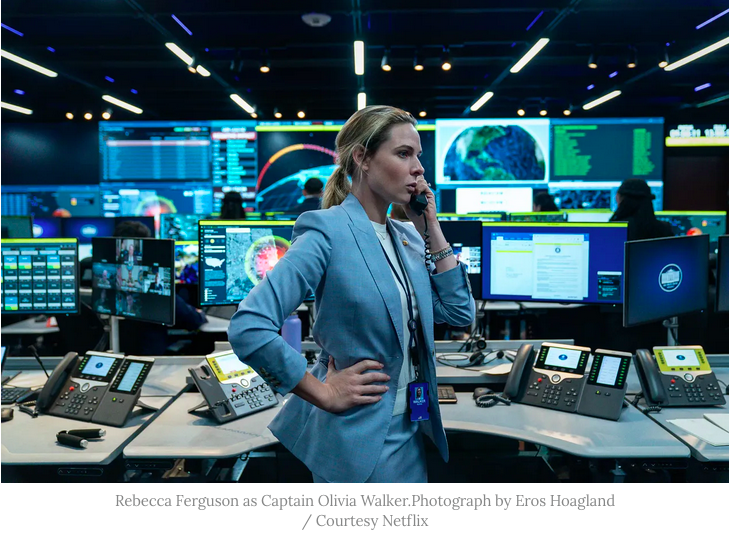By Marianne Hanson, Co-Chair, ICAN Australia
11 November 2025
If there’s one message we should take away from Academy Award winning director Kathryn Bigelow’s new film A House of Dynamite, it is this: nuclear weapons cannot keep us ‘safe’ indefinitely. Sooner or later, the kind of scenario depicted in Bigelow’s film will occur. Indeed, many situations have already arisen where nuclear weapons were nearly used, as a result of miscalculation or misperception. It is only luck that has prevented nuclear weapons from being launched after 1945.
But that luck will not hold indefinitely. The film shows clearly that mistakes can happen, technology can fail, people do not always act rationally. Above all, nobody really knows for sure how such a crisis will be handled or whether it can be handled successfully at all.
The film depicts a chilling snapshot of what might happen when a nuclear weapon is launched (in this case from an unknown state, against America). As officials scramble to get information and then try to intercept the incoming bomb—which is calculated to destroy Chicago and around 10 million people—it becomes evident that nobody is really prepared.
In the film, even a fundamental operation, connecting the US President with the Russian Foreign Minister by phone, becomes difficult. It is not possible to merge two conversations into one phone call. Technology is wonderful. Until it isn’t.
Similarly, being able to intercept and destroy any incoming missile is a concept designed to assure the ordinary American, but as the film shows, around half the time such attempts will fail. The Pentagon has criticized the film, claiming that missile interception tests work with ‘100% accuracy’. Yet no one familiar with the complexities agrees with this absurd claim.
A key question facing the US President is how he is going to react to the attack. But not knowing from which country the missile originated, whether it was launched deliberately or by accident, and whether or not a counterattack will escalate hostilities and lead to complete annihilation makes such decisions extremely difficult. Implicitly, we are asked to consider whether it is ever justified to retaliate by killing millions of innocent people.
Such uncertainties always accompany the reality of nuclear deterrence, which claims that having nuclear weapons means that no state will attack you, because it would face nuclear retaliation. These uncertainties are never really acknowledged by advocates of nuclear deterrence. Instead, we are told that the right decisions can be made by our leaders acting rationally (and presumably by our opponents’ leaders doing so also), that we will always have the right information, and that technology is our friend. A House of Dynamite puts paid to such notions. If it ever did carry much weight, deterrence theory is even more unreliable today, as the possibility of cyber-attacks, unauthorized launches, and simple human fallibility can lead to irreversible mistakes.
A House of Dynamite does a good job at alerting the world to the risk of nuclear dangers. But it doesn’t go far enough. In reality, decision-makers would probably have to deal with dozens if not hundreds of nuclear-armed missiles coming in at any one time. Today’s nuclear stockpiles, held by nine states, amount to the equivalent of over 146,000 Hiroshima-sized bombs. If even a small fraction of those weapons was used, the entire world would face climate, agricultural, radiation, and social challenges like never before. Perhaps one film alone cannot show the catastrophic results of a nuclear war. In the film, we are left to imagine the effect of the strike on Chicago
A House of Dynamite also doesn’t tell us anything about what is being done to avoid such catastrophes. The movie implies that we have had no choice, that a nuclear attack is likely and that we must accept our nuclear fate. But that is only true if we let our leaders continue with their complacency.
The fact is that plenty of states, civil society groups, and individuals are very active in raising awareness of nuclear dangers. Kathryn Bigelow speaks in interviews about the need for us to be much more informed about nuclear weapons. But there is a vast amount of up to date and highly reputable scientific and political information already available.
The problem is not a lack of information. The problem is that many of our leaders, especially the leaders of the nine nuclear weapon states, refuse to act. Around half the world’s states, including almost all of Australia’s neighbours in southeast Asia and the South Pacific have signed the UN Treaty on the Prohibition of Nuclear Weapons (TPNW). But in Australia, the government is yet to fulfil its promise to sign this treaty, despite the fact that almost 70% of Australians polled are in favour of doing so. They understand that fears of jeopardizing our alliance with the US are overblown.
The film states that ‘at the end of the Cold War, global powers reached the consensus that fewer nuclear weapons would be better’. Actually, what leaders like Ronald Reagan and Mikhail Gorbachev really argued was that the world would be better without any nuclear weapons at all. And we could have pursued that path, but it has been hijacked by entrenched nuclearism and vested interests.
The reality is that today we are closer than ever to a nuclear tragedy, whether by accident or design. Almost every one of the arms control agreements and confidence building measures reached during and just after the Cold War have been jettisoned, and all the nuclear weapon states are modernizing, and in some cases increasing, their arsenals.
The complete elimination of nuclear weapons won’t happen overnight. But building up political and moral pressure against those few states that continue to stand outside international law on this issue is vital.
This makes films like A House of Dynamite all the more essential viewing.
Thanks for reading ICAN’s Substack! Subscribe for free to receive new posts and support my work.

